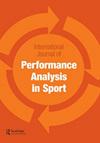古罗马式摔跤中上篮的生物力学:国际比赛的定性和时间运动分析
IF 1.6
4区 教育学
Q1 Health Professions
International Journal of Performance Analysis in Sport
Pub Date : 2023-01-02
DOI:10.1080/24748668.2023.2181563
引用次数: 0
摘要
摘要suplex是古罗马摔跤和一般摔跤中最重要、最壮观的进攻动作之一,但迄今为止,还没有发表的生物力学研究对其进行系统描述。我们进行了定性生物力学分析,对suplex的变体进行了分类,并将这种复杂的动作分为阶段和动作。由于suplex的效力在很大程度上取决于执行速度,我们分析了最高级别国际比赛公开视频中的80次suplex投掷,以描述不同阶段和动作的持续时间,以及这些在suplex变体中的变化。我们观察到腹对腹与腹对背的偏好,以及上腹外侧与额侧变体的偏好。我们发现不同变体的重要阶段/动作的持续时间存在差异,包括准备阶段(腹部到背部变体更长)和投射阶段的后弓(前部变体更长),而我们没有发现秋季获胜频率存在差异的证据。我们的研究提供了一个有用的框架来评估和监测超级动作的执行,通过信息来帮助在特定的比赛环境中选择一种变体,对其复杂动作的系统描述来进行更集中的训练,以及其动作组成部分的“金标准”持续时间。本文章由计算机程序翻译,如有差异,请以英文原文为准。
Biomechanics of suplex in Greco-Roman wrestling: a qualitative and time-motion analysis of international competitions
ABSTRACT The suplex is one of the most important and spectacular offensive moves in Greco-Roman wrestling, and wrestling in general, but to date no published biomechanical study has systematically described it. We performed a qualitative biomechanical analysis to classify variants of suplex, and to split this complex move into phases and actions within them. As suplex efficacy highly depends on speed of execution, we analysed 80 suplex throws from publicly available videos of international matches at the highest level to describe the duration of the different phases and actions, and how these vary across variants of suplex. We observed a preference for belly-to-belly vs belly-to-back and for lateral vs frontal variants of suplex. We show differences in duration of important phases/actions across variants, including the preparation phase (longer for belly-to-back variants) and the back arch in the projection phase (longer for frontal variants), while we find no evidence of a difference in the frequency of win by fall. Our study provides a useful framework to evaluate and monitor suplex execution, through information to help choose a variant in specific match contexts, a systematic description of its complex motion to allow a more focused training, and “gold-standard” durations of its movement components.
求助全文
通过发布文献求助,成功后即可免费获取论文全文。
去求助
来源期刊

International Journal of Performance Analysis in Sport
SPORT SCIENCES-
CiteScore
4.70
自引率
4.80%
发文量
38
审稿时长
>12 weeks
期刊介绍:
The International Journal of Performance Analysis in Sport aims to present current original research into sports performance. In so doing, the journal contributes to our general knowledge of sports performance making findings available to a wide audience of academics and practitioners.
 求助内容:
求助内容: 应助结果提醒方式:
应助结果提醒方式:


